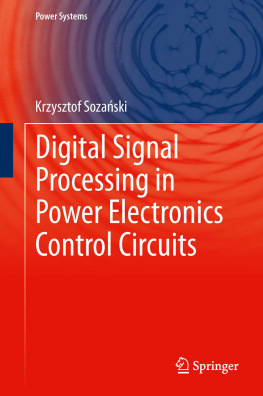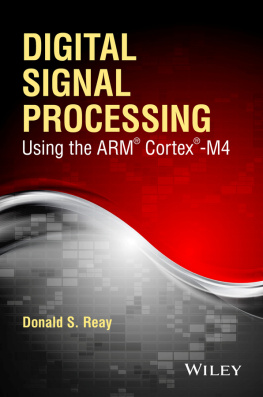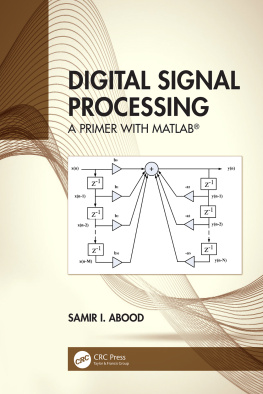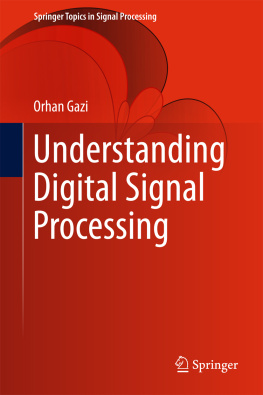Richard G. Lyons - Understanding Digital Signal Processing 3rd Edition c2011 (Lyons)
Here you can read online Richard G. Lyons - Understanding Digital Signal Processing 3rd Edition c2011 (Lyons) full text of the book (entire story) in english for free. Download pdf and epub, get meaning, cover and reviews about this ebook. publisher: Prentice Hall, genre: Computer. Description of the work, (preface) as well as reviews are available. Best literature library LitArk.com created for fans of good reading and offers a wide selection of genres:
Romance novel
Science fiction
Adventure
Detective
Science
History
Home and family
Prose
Art
Politics
Computer
Non-fiction
Religion
Business
Children
Humor
Choose a favorite category and find really read worthwhile books. Enjoy immersion in the world of imagination, feel the emotions of the characters or learn something new for yourself, make an fascinating discovery.

- Book:Understanding Digital Signal Processing 3rd Edition c2011 (Lyons)
- Author:
- Publisher:Prentice Hall
- Genre:
- Rating:4 / 5
- Favourites:Add to favourites
- Your mark:
- 80
- 1
- 2
- 3
- 4
- 5
Understanding Digital Signal Processing 3rd Edition c2011 (Lyons): summary, description and annotation
We offer to read an annotation, description, summary or preface (depends on what the author of the book "Understanding Digital Signal Processing 3rd Edition c2011 (Lyons)" wrote himself). If you haven't found the necessary information about the book — write in the comments, we will try to find it.
Understanding Digital Signal Processing 3rd Edition c2011 (Lyons) — read online for free the complete book (whole text) full work
Below is the text of the book, divided by pages. System saving the place of the last page read, allows you to conveniently read the book "Understanding Digital Signal Processing 3rd Edition c2011 (Lyons)" online for free, without having to search again every time where you left off. Put a bookmark, and you can go to the page where you finished reading at any time.
Font size:
Interval:
Bookmark:
Third Edition

Upper Saddle River, NJ Boston Indianapolis San Francisco
New York Toronto Montreal London Munich Paris Madrid
Capetown Sydney Tokyo Singapore Mexico City
Many of the designations used by manufacturers and sellers to distinguish their products are claimed as trademarks. Where those designations appear in this book, and the publisher was aware of a trademark claim, the designations have been printed with initial capital letters or in all capitals.
The author and publisher have taken care in the preparation of this book, but make no expressed or implied warranty of any kind and assume no responsibility for errors or omissions. No liability is assumed for incidental or consequential damages in connection with or arising out of the use of the information or programs contained herein.
The publisher offers excellent discounts on this book when ordered in quantity for bulk purchases or special sales, which may include electronic versions and/or custom covers and content particular to your business, training goals, marketing focus, and branding interests. For more information, please contact:
U.S. Corporate and Government Sales
(800) 382-3419
For sales outside the United States please contact:
International Sales
Visit us on the Web: informit.com/ph
Library of Congress Cataloging-in-Publication Data
Lyons, Richard G., 1948
Understanding digital signal processing / Richard G. Lyons.3rd ed.
p. cm.
Includes bibliographical references and index.
ISBN 0-13-702741-9 (hardcover : alk. paper)
1. Signal processingDigital techniques. I. Title.
TK5102.9.L96 2011
621.3822dc22 2010035407
Copyright 2011 Pearson Education, Inc.
All rights reserved. Printed in the United States of America. This publication is protected by copyright, and permission must be obtained from the publisher prior to any prohibited reproduction, storage in a retrieval system, or transmission in any form or by any means, electronic, mechanical, photocopying, recording, or likewise. For information regarding permissions, write to:
Pearson Education, Inc.
Rights and Contracts Department
501 Boylston Street, Suite 900
Boston, MA 02116
Fax: (617) 671-3447
ISBN-13: 978-0-13-702741-5
ISBN-10: 0-13-702741-9
Text printed in the United States on recycled paper at Edwards Brothers in Ann Arbor, Michigan.
Second printing, April 2011
I dedicate this book to my daughters, Julie and MeredithI wish I could go with you; to my mother, Ruth, for making me finish my homework; to my father, Grady, who didnt know what he started when he built that workbench in the basement; to my brother Ray for improving us all; to my brother Ken who succeeded where I failed; to my sister Nancy for running interference for us; and to the skilled folks on the USENET newsgroup comp.dsp. They ask the good questions and provide the best answers. Finally, to Sigi Pardula (Batgirl): Without your keeping the place running, this book wouldnt exist.
This book is an expansion of previous editions of Understanding Digital Signal Processing. Like those earlier editions, its goals are (1) to help beginning students understand the theory of digital signal processing (DSP) and (2) to provide practical DSP information, not found in other books, to help working engineers/scientists design and test their signal processing systems. Each chapter of this book contains new information beyond that provided in earlier editions.
Its traditional at this point in the preface of a DSP textbook for the author to tell readers why they should learn DSP. I dont need to tell you how important DSP is in our modern engineering world. You already know that. Ill just say that the future of electronics is DSP, and with this book you will not be left behind.
This third edition is appropriate as the text for a one- or two-semester undergraduate course in DSP. It follows the DSP material I cover in my corporate training activities and a signal processing course I taught at the University of California Santa Cruz Extension. To aid students in their efforts to learn DSP, this third edition provides additional explanations and examples to increase its tutorial value. To test a students understanding of the material, homework problems have been included at the end of each chapter. (For qualified instructors, a Solutions Manual is available from Prentice Hall.)
To help working DSP engineers, the changes in this third edition include, but are not limited to, the following:
Practical guidance in building discrete differentiators, integrators, and matched filters
Descriptions of statistical measures of signals, variance reduction by way of averaging, and techniques for computing real-world signal-to-noise ratios (SNRs)
A significantly expanded chapter on sample rate conversion (multirate systems) and its associated filtering
Implementing fast convolution (FIR filtering in the frequency domain)
IIR filter scaling
Enhanced material covering techniques for analyzing the behavior and performance of digital filters
Expanded descriptions of industry-standard binary number formats used in modern processing systems
Numerous additions to the popular chapter
Learning the fundamentals, and how to speak the language, of digital signal processing does not require profound analytical skills or an extensive background in mathematics. All you need is a little experience with elementary algebra, knowledge of what a sinewave is, this book, and enthusiasm. This may sound hard to believe, particularly if youve just flipped through the pages of this book and seen figures and equations that look rather complicated. The content here, you say, looks suspiciously like material in technical journals and textbooks whose meaning has eluded you in the past. Well, this is not just another book on digital signal processing.
In this book I provide a gentle, but thorough, explanation of the theory and practice of DSP. The text is not written so that you may understand the material, but so that you must understand the material. Ive attempted to avoid the traditional instructorstudent relationship and have tried to make reading this book seem like talking to a friend while walking in the park. Ive used just enough mathematics to help you develop a fundamental understanding of DSP theory and have illustrated that theory with practical examples.
I have designed the homework problems to be more than mere exercises that assign values to variables for the student to plug into some equation in order to compute a result. Instead, the homework problems are designed to be as educational as possible in the sense of expanding on and enabling further investigation of specific aspects of DSP topics covered in the text. Stated differently, the homework problems are not designed to induce death by algebra, but rather to improve your understanding of DSP. Solving the problems helps you become proactive in your own DSP education instead of merely being an inactive recipient of DSP information.
Learning digital signal processing is not something you accomplish; its a journey you take. When you gain an understanding of one topic, questions arise that cause you to investigate some other facet of digital signal processing.. This book is your tour guide during the first steps of your journey.
You see I went on with this research just the way it led me. This is the only way I ever heard of research going. I asked a question, devised some method of getting an answer, and gota fresh question. Was this possible, or that possible? You cannot imagine what this means to an investigator, what an intellectual passion grows upon him. You cannot imagine the strange colourless delight of these intellectual desires (Dr. Moreauinfamous physician and vivisectionist from H.G. Wells
Font size:
Interval:
Bookmark:
Similar books «Understanding Digital Signal Processing 3rd Edition c2011 (Lyons)»
Look at similar books to Understanding Digital Signal Processing 3rd Edition c2011 (Lyons). We have selected literature similar in name and meaning in the hope of providing readers with more options to find new, interesting, not yet read works.
Discussion, reviews of the book Understanding Digital Signal Processing 3rd Edition c2011 (Lyons) and just readers' own opinions. Leave your comments, write what you think about the work, its meaning or the main characters. Specify what exactly you liked and what you didn't like, and why you think so.









